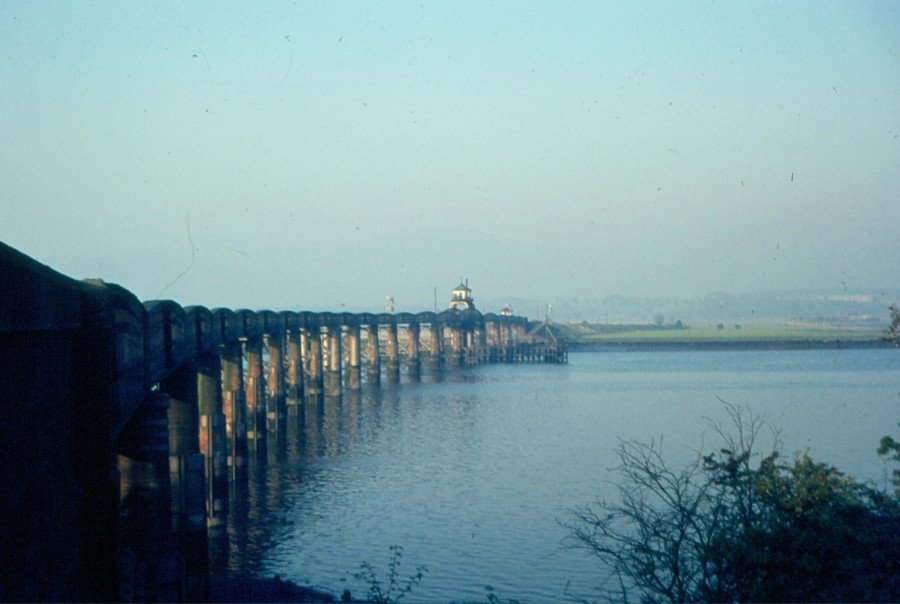Alloa Bridge
Location type
BridgeName and dates
Alloa Bridge (1885-1970)Opened on the Alloa Railway.
Description
This was a single track viaduct over the River Forth with a central swing section.
Also known as Alloa Swing Bridge, the Throsk Viaduct or 'The Other Forth Bridge'.
The bridge was 1615 ft long overall. This was a 20 section bridge, a series of steel bowstring girders. Mounted in the middle of the swinging section was a control cabin above track level, this section pivoting in the middle. This was powered by a steam engine in the pivoting point, built at the St Rollox Works. Above the pivot was the control tower, a octagonal building above the swinging girder and track. The navigable part of the river was at the north of the channel. Girders on either side of the swinging section were longer within the navigable channel. The arrangement was, from the north, 4 fixed girders, a single rotating girder, and 15 fixed girders.
The engineers for the Caledonian Railway were Crouch and Hogg, and contractors for this bridge Watt and Wilson.
The last traffic over the bridge was in 1968, local railbuses from Larbert to Alloa and longer distance services with DMUs. Following this the bridge continued to swing until 1970 when it was fixed open. Up to this date coal was still delivered by rail for the steam engine. Demolition was between 1971 and 1972.
The piers still stand but girders and swing section have been removed.
The line was double track at either end, the southern approach being controlled by Throsk signal box and northern approach by Forth Bridge Signal Box. The steam engine is now at the Scottish Maritime Museum in Irvine.
The bridge was required to swing to allow shipping access upstream to Stirling. The approach was far from easy as an approaching vessel would be unaware of whether the bridge was opened or closed, the bridge being low lying and round a bend on the approach from either direction. With the current of the river and tides a vessel could not always stop and there was little time to open the bridge for its operator. Crew spoke of 'shooting' the bridge. Due to these complications regular service vessels were fitted with hinged masts and funnels.
In strong wing a vessel was blown against the bridge in 1899.
The bridge was closed between 1904 and 1905 following damage when the schooner 'Stirling', under tow, struck the bridge damaging girders on the 12th of October 1904. One pair of braced piers fell entirely and two spans fell with it. The track was left dangling over the gap.
A surrendered German warship broke its mooring and struck the bridge resulting in its closure between 1920 and 1921. Spans 10 and 11 were destroyed. The bridge was rebuilt with some piers entirely replaced and additional cross bracing added.
There was a safety boathouse on the north bank, just east of the bridge.
Tags
ViaductAliases
The Other Forth Bridge Forth Bridge [Alloa] Alloa Swing Bridge Throsk ViaductExternal links
Canmore site recordNLS Collection OS map of 1892-1914
NLS Collection OS map of 1944-67
NLS Map
NLS Map
| Nearby stations Throsk South Alloa Alloa Ferry Cambus Alloa [1st] Alloa Plean Blackgrange Airth Bannockburn Manor Powis Sauchie Clackmannan and Kennet Menstrie and Glenochil Alloa Junction | Eglinton Bottling Stores Longcarse Junction Iron Foundry Kelliebank Glass Works Forth Shipbuilding Yard Weirs Pumps Kelliebank Bottling Stores Alloa Shed [CR] Alloa Glass Works Alloa Marshalling Yard Bass Crest Brewery Dunmore Junction Alloa Goods [CR] Tourist/other Forth Bridge Signal Box RNAD Bandeath |
| Location names in dark blue are on the same original line. | |
Diversionary RouteThe North British Railway had running rights over the Alloa Bridge, owned by the Caledonian Railway. When a diversion was necessary both companies ran from Larbert to Stirling (Caledonian owned) and then to Alloa [1st] (North British owned). Diversions were necessary several times following the bridge being struck by vessels (see main entry for the Alloa Bridge). |
Chronology Dates
| 11/08/1879 | Alloa Railway Authorised to build a line from the South Alloa Branch (Scottish Central Railway), a swing bridge, Alloa Bridge, over the River Forth and line into Alloa. |
| 01/10/1885 | Alloa Railway
South Alloa Branch (Scottish Central Railway) Line from Dunmore Junction to Alloa West Junction and swing bridge, Alloa Bridge opened. Caledonian Railway trains start to use Alloa [1st] station. Dunmore Junction to South Alloa closed to passengers. Alloa Goods [CR] opened. |
| 12/10/1904 | Alloa Railway Alloa Bridge (swing) closed due to storm damage. |
| 12/10/1904 | Alloa Railway Alloa Bridge is badly damaged after being struck by the schooner 'Stirling' resulting in the fall of a span. The Caledonian Railway is allowed to reroute its trains to Alloa via Stirling. North British Railway trains also diverted. |
| 01/06/1905 | Alloa Railway Alloa Bridge re-opened. |
| 01/06/1905 | Alloa Railway Alloa Bridge repairs complete and Caledonian Railway trains to Alloa return to their usual route. |
| 15/08/1920 | Alloa Railway Alloa Bridge (swing) closed due to storm damage. |
| 15/08/1920 | Alloa Railway A surrendered German warship broke its mooring and struck Alloa Bridge resulting in its closure between 1920 and 1921. Spans 10 and 11 were destroyed. |
| 01/03/1921 | Alloa Railway Alloa Bridge re-opened. |
| 01/03/1921 | Alloa Railway The Alloa Bridge re-opens following repairs. The bridge was rebuilt with some piers entirely replaced and additional cross bracing added. |
| 29/01/1968 | Alloa RailwaySouth Alloa Branch (Scottish Central Railway) Alloa (Alloa West Junction) to Larbert (Alloa Junction) closed to passengers. Railbuses cease crossing the Alloa Bridge. |
| 08/02/1971 | Alloa Railway Demolition of Alloa Bridge. |
News items
| 18/05/2021 | Abandoned Forth crossing may form part of active travel plan [Alloa Advertiser] |










